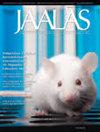延长笼内构件卫生间隔对大鼠(褐家鼠)微环境、健康和胃肠道微生物组的影响。
IF 1.7
3区 农林科学
Q3 VETERINARY SCIENCES
Journal of the American Association for Laboratory Animal Science
Pub Date : 2023-05-01
Epub Date: 2023-04-18
DOI:10.30802/AALAS-JAALAS-22-000113
引用次数: 0
摘要
清洗和消毒鼠笼组件需要昂贵的设备、大量的人力和自然资源。传统上,单独通风笼(IVC)的卫生基准频率为每2周一次。在这项研究中,我们研究了延长这一间隔对大鼠笼内微环境、基本健康标志物和胃肠道微生物群的影响。我们比较了我们的机构标准,即将大鼠笼盖、箱式喂食器和浓缩装置的卫生间隔从每4周改为12周。两组的笼底和垫层继续每2周更换一次。我们假设,我们目前4周的实践和12周的持续使用之间没有显著差异。我们的数据显示,两组中大多数笼子的笼内氨水平都保持在5ppm以下,但经历笼内洪水的笼子除外。我们发现两组在笼状物成分上的菌落形成单位(CFU)没有显著差异。我们使用了3种新的方法来评估富集装置的清洁度,发现连续使用12周对CFU数量没有显著影响。此外,我们发现各组在动物体重、常规血液检查或粪便和盲肠微生物组方面没有显著差异。这些数据表明,大鼠IVC笼中成分长达12周的卫生间隔对大鼠的微环境或健康没有显著影响。使用更长的间隔将提高效率,减少自然资源的使用,降低成本,同时保持高质量的动物护理。本文章由计算机程序翻译,如有差异,请以英文原文为准。
Effects of Extended Cage Component Sanitation Interval on the Microenvironment, Health, and Gastrointestinal Microbiome of Rats (Rattus norvegicus).
Washing and sanitizing rodent cage components requires costly equipment, significant personnel effort, and use of natural resources. The benchmark frequency for sanitation of individually ventilated caging (IVC) has traditionally been every 2 wk. In this study, we investigated the effects of extending this interval on the cage microenvironment, basic markers of health, and the gastrointestinal microbiota of rats. We compared our institutional standard of changing the sanitation interval for rat cage lids, box feeders, and enrichment devices from every 4 wk to an interval of 12 wk. The cage bottom and bedding continued to be changed every 2 wk for both groups. We hypothesized that we would find no significant difference between our current practice of 4 wks and continuous use for 12 wk. Our data showed that intracage ammonia levels remained below 5 ppm for most cages in both groups, with the exception of cages that experienced a cage flood. We found no significant difference between groups in bacterial colony forming units (CFU) on cage components. We used 3 novel methods of assessing cleanliness of enrichment devices and found no significant effect of continuous use for 12 wk on the number of CFU. In addition, we found no significant differences between groups for animal weight, routine blood work, or fecal and cecal microbiomes. These data indicate that a sanitation interval of up to 12 wk for components of rat IVC caging has no significant effects on the microenvironment or health of rats. Using the longer interval will improve efficiency, reduce the use of natural resources, and decrease costs while maintaining high-quality animal care.
求助全文
通过发布文献求助,成功后即可免费获取论文全文。
去求助
来源期刊
CiteScore
3.10
自引率
35.30%
发文量
122
审稿时长
6-12 weeks
期刊介绍:
The Journal of the American Association for Laboratory Animal Science (JAALAS) serves as an official communication vehicle for the American Association for Laboratory Animal Science (AALAS). The journal includes a section of refereed articles and a section of AALAS association news.
All signed articles, including refereed articles and book reviews, editorials, committee reports, and news and commentary, reflect the individual views of the authors and are not official views of AALAS. The mission of the refereed section of the journal is to disseminate high-quality, peer-reviewed information on animal biology, technology, facility operations, management, and compliance as relevant to the AALAS membership. JAALAS accepts research reports (data-based) or scholarly reports (literature-based), with the caveat that all articles, including solicited manuscripts, must include appropriate references and must undergo peer review.

 求助内容:
求助内容: 应助结果提醒方式:
应助结果提醒方式:


